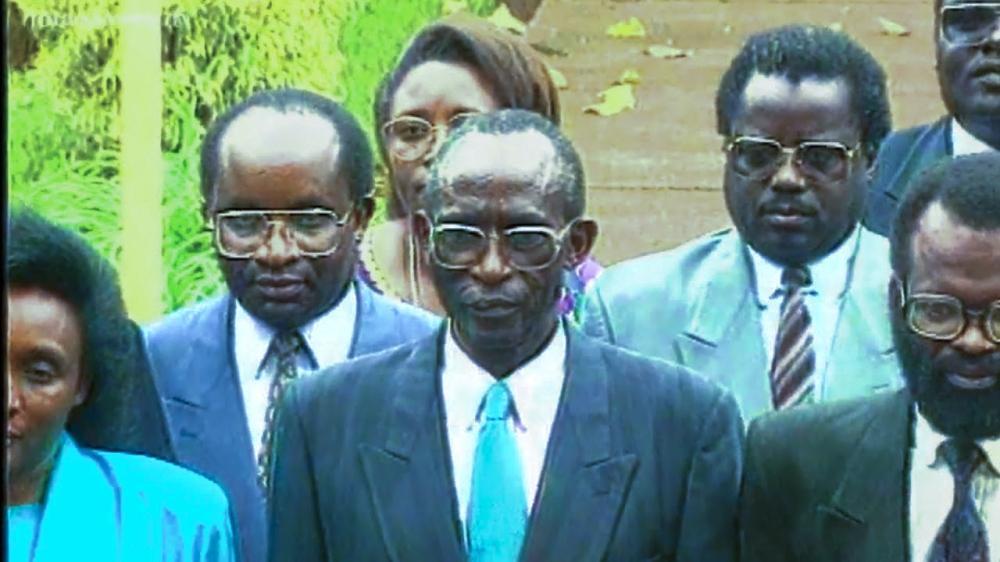Africa-Press – Rwanda. On April 17, 1994, the genocidal government held a meeting in which some Governors were replaced by others considered more capable of speeding up the killings in their respective prefectures.
Jean-Baptiste Habyarimana, the former governor of Butare and Godefroid Ruzindana of Kibungo were sacked and later on murdered together with their families.
New extremist Governors were inaugurated. Those included François Karera for Kigali Ngari, Sylvain Nsabimana for Butare, Anaclet Rudakubana for Kibungo, Elie Nyirimbibi for Byumba, Basile Nsabumugisha for Ruhengeri and Dr Charles Zirimwabagabo for Gisenyi.
Many of these were later convicted of Genocide crimes later on after Rwanda came out of the atrocities. Karera was convicted by the International Criminal Tribunal for Rwanda (ICTR) and was sentenced to life imprisonment while Nsabimana was sentenced to 18 years of imprisonment.
Zirimwabagabo was tried by Gacaca courts and sentenced to life imprisonment. Some others are still at large.
April 17, 1994 was characterised by many killings in various places. Between April 15 and 17, a notorious Interahamwe leader called Hassani Rubayiza had established a roadblock in Kitabi centre near Mont Kigali where many Tutsi were killed and thrown into mining pits nearby.
More Tutsi were murdered at the home of Calcutta Sisters near St. Famille catholic church in Kigali, where they had taken refuge. Interahamwe attacked them, killing many including women and children.
These Interahamwe attacks were headed by Odette Nyirabagenzi Odette (Councilor of Rugenge Sector) and Angeline Mukandutiye (The Inspector of Nyarugenge Schools). The latter also supplied guns to Interahamwe and her home was used to host them.
After the Genocide, Mukandutiye fled to Zaire (current Democratic Republic of Congo). She was sentenced to life imprisonment by Gacaca courts, in her absentia.
Later in 2019, she came back to Rwanda and was handed over to Nyarugenge district prison to serve the sentence.
At Kigali University Teaching Hospital (CHUK), many Tutsi including patients, their caretakers and other people who had taken refuge at the facility were attacked and massacred from there.
According to records, many of the hospital staff were characterised by genocide ideology and hatred. For instance, towards the end of 1993, some doctors were supplied with guns allegedly for their protection.
In addition to that, Dr Faustin Kanyangabo, the former Director of the Hospital allowed armed soldiers to reside at the hospital’s premises, claiming it was for security purposes.
Working with some medics within the hospital, the soldiers carried out a census of the Tutsi at the hospital, to avoid killing Hutu mistakenly. Interahamwe were camping near the Hospital waiting to kill all Tutsi thrown out by the doctors.
On April 17, medics including Benoit Nteziryayo, Edithe Mukakabera worked with a soldier called Pierre Kamashini to check patients’ ID cards to establish their ethnicity.
They handed the Hutu their IDs back, but kept those belonging to the Tutsi.
The Tutsi patients were discharged immediately and as they made their way home, they were killed by Interahamwe near the hospital.
Among the doctors, nurses and hospital staff who took part in the plot to kill the Tutsi at CHUK were Dr Benoit Ntezayabo (was sentenced by Gacaca court in absentia for 30 years of imprisonment), and Dr Theoneste Habyarimana (also sentenced to life imprisonment by Gacaca court in absentia).
At Ndera Neuropsychiatric Teaching Hospital, approximately 3,500 Tutsi were massacred, having taken refuge at the facility from various residential areas including Ndera, Rubungo, Jurwe, Murindi, Gasogi, Kanombe and Remera.
Interahamwe had started to attack them as early as April 8, from outside of the fence.
However, they could not kill many as they tried to fight back using traditional weapons.
On April 17, with support from Kanombe military camp, Interahamwe demolished the fence and entered the facility. Using weapons like grenades and guns, the soldiers massacred many people. Those who had not died were left for Interahamwe to finish them off.
Other parts of the country also continued to face massacres on April 17, 1994. These include Nyaruguru, where many were killed as they tried to flee to Burundi.
In Bweyeye (currently in Rusizi district), a large number of Tutsi were killed at an ADEPR church. A gang-rape crime was also committed against Petronile Mukakarera, a Tutsi woman, who got killed afterwards.
For More News And Analysis About Rwanda Follow Africa-Press






